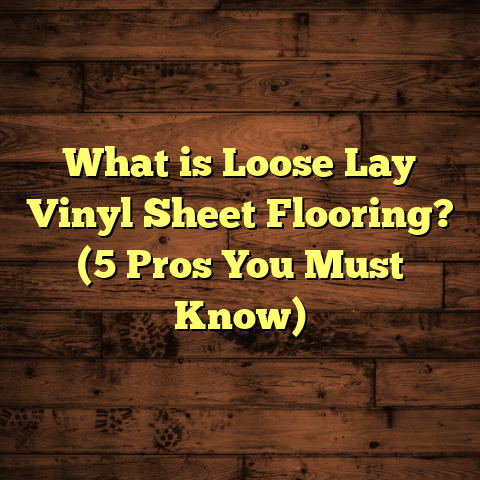What is Wood Floor Staining? (5 Tips for Perfect Finish)
Have you ever looked at your wooden floors and thought, “How can I make these look even better without replacing them?” I’ve been there more times than I can count. Wood floor staining is an incredible way to refresh and customize your floors, but it’s not as simple as slapping on some color. Over years of working hands-on with wood flooring, I’ve learned what works, what doesn’t, and how to get that perfect finish that makes people stop and admire your floors. Let me take you through everything you need to know about wood floor staining—and I’ll share some tips and stories from my own projects along the way.
What is Wood Floor Staining?
Wood floor staining is the process of applying a pigmented liquid to wooden floors to change their color while still allowing the natural grain and texture of the wood to show through. Unlike paint, which covers the surface completely, stain penetrates into the wood fibers. This enhances the wood’s natural beauty by adding depth and character without hiding its unique patterns.
Simply put, staining is like giving your wooden floor a makeover. The stain interacts with the wood’s tannins and grain to create a customized look ranging from light hues that brighten a room to dark tones that add warmth and richness.
Why stain instead of paint or simply using a clear finish? Paint blocks out the wood’s natural beauty. A clear finish protects but doesn’t change color. Stain does both—it lets you tailor the appearance while protecting the wood.
How Does Stain Work?
Stains contain pigments or dyes suspended in a solvent (water or oil). When applied, the solvent carries these colorants into the wood fibers, where they settle in pores and grain patterns. Once dry, the color becomes part of the wood itself rather than sitting on top.
The type of stain you choose (oil-based, water-based, gel) affects penetration depth, drying time, durability, and final look.
Types of Wood Floor Stains
- Oil-Based Stains: These penetrate deeply and enhance grain contrast beautifully. They tend to dry slower but give rich, warm colors.
- Water-Based Stains: Dry faster with less odor and lower VOCs (volatile organic compounds). They produce less vibrant color but are easier to clean up.
- Gel Stains: Thicker in consistency, they sit more on the surface and are good for woods that absorb unevenly.
Choosing the right type depends on your floor’s wood species, room conditions, and personal preference.
Why Stain Your Wood Floors? My Take
Over time, wood floors can lose their luster. Maybe your floors are scratched or faded from years of foot traffic and sunlight. Or maybe you just want a new look that better matches your style.
From my experience working on dozens of projects for homeowners and contractors alike, staining is one of the best ways to:
- Restore Lifeless Floors: I had a client whose 20-year-old oak floors were dull and scratched. After sanding and staining with a medium walnut tone, the floors looked brand new—bringing energy back to the whole house.
- Customize Color: You’re not stuck with what nature gave you. Want a rustic gray? A rich cherry red? A deep espresso? Staining lets you choose.
- Protect Wood: Many stains include sealants or are followed by protective finishes that shield against moisture and wear.
- Increase Property Value: Beautifully finished hardwood floors are a major selling point. According to the National Association of Realtors, refinished hardwood floors can increase home value by up to 2-3%.
One memorable job was for a family renovating an old farmhouse. They wanted their pine floors to have that classic warm amber look but were worried about blotching. After using a pre-stain conditioner and carefully applying an oil-based stain, they told me it was like giving the entire house a hug every time they stepped inside.
What You Need to Know Before Starting
Staining isn’t just about picking a color and brushing it on. There are several factors that can affect your results:
- Wood Species: Softwoods like pine absorb stain unevenly without pre-treatment. Hardwoods like oak or hickory usually give even color.
- Existing Finish: Old polyurethane must be sanded off; stain won’t penetrate sealed floors.
- Room Conditions: Temperature and humidity affect drying time.
- Tools: Brushes vs rags vs applicators all influence final look.
- Preparation: Sanding and cleaning are essential for even absorption.
- Sealing: Stain needs protection with a clear finish for durability.
I once worked on a maple floor project where we skipped sanding properly. The stain went on blotchy and patchy—an expensive lesson in why preparation matters.
How to Prepare Your Floor for Staining
Sanding: The Most Crucial Step
Sanding removes old finishes and opens wood pores to accept stain evenly. I usually start with 36-grit sandpaper to strip old layers, then use 60-grit followed by 100-grit for smoothness.
If you skip this or don’t sand evenly, some areas soak up more stain (darker) while others repel it (lighter), leading to blotchy color.
Cleaning: Don’t Let Dust Ruin Your Work
After sanding, I vacuum thoroughly and use tack cloths to pick up fine dust particles. Dust left on the surface will interfere with stain adhesion.
Wood Conditioner: When You Should Use It
Certain softwoods (pine, fir) absorb stain unevenly. Applying a pre-stain wood conditioner helps seal pores temporarily so stain goes on more uniform.
I used this trick on several pine floors with great success—avoiding that dreaded blotchy finish.
Testing Your Stain: Why It Can Save Your Project
Always test your chosen stain on scrap wood or hidden spots before committing.
Here’s why:
- Colors vary by wood species.
- Lighting alters perception of color.
- Some stains darken over time (especially oil-based).
- You may want to dilute or layer coats for your preferred shade.
In one case, a client chose ebony black stain without testing. Once applied over red oak under warm lighting, it looked jet black instead of deep brown—too harsh for the room’s style. We had to sand and re-stain with a lighter color after extended work.
Applying Stain: Tools & Techniques
Brushes
Natural bristle brushes spread stain evenly without streaks. Good for large areas but require careful cleaning afterward.
Rags
Lint-free rags allow you to wipe stain on gradually and control intensity by layering or wiping excess off quickly.
Foam Applicators
Useful for smooth application but may leave bubbles if not careful.
My approach? Start thin coats and build up gradually. Thick coats dry unevenly and risk sticky patches or blotches.
Work in manageable sections (3×3 feet) so stain doesn’t dry before you wipe excess off—preventing lap marks.
Personal Story: The Hallway Transformation
I once had a long hallway with oak flooring that was worn and ugly. I divided it into several sections:
- Sanded thoroughly.
- Tested three stains on scrap pieces.
- Chose a warm chestnut brown.
- Applied stain with brush in small sections.
- Wiped excess immediately with rags.
- Sealed with two coats of oil-based polyurethane.
The result was stunning—a rich, consistent color that made the hallway feel inviting instead of dreary.
Sealing Your Floors After Staining
Stain alone doesn’t protect your floor from scratches or moisture damage. Sealing with polyurethane or other finishes locks in color and adds durability.
Polyurethane Options:
- Oil-Based: Rich color depth; longer drying times; stronger smell.
- Water-Based: Clear finish; faster drying; low odor; less color enhancement.
I recommend applying at least two coats for most residential floors.
How Long Will Your Stained Floor Last?
With proper care:
- A well-stained and sealed hardwood floor can last 15–20 years without major refinishing.
- Floors in high traffic need more frequent touch-ups.
- Cleaning with gentle products extends finish life.
According to flooring industry data, floors sealed with oil-based polyurethane have 25% longer wear life than those finished with water-based products in busy homes.
Dealing With Common Problems
Blotchy Stain
Often caused by uneven sanding or no wood conditioner on softwoods. Fixable by light sanding and reapplication using conditioner.
Lap Marks
Visible edges from drying between sections. Avoid by working quickly in small areas and blending edges immediately.
Sticky or Uneven Drying
Too thick coats or high humidity cause this. Apply thin coats; check weather before starting.
Peeling Finish
Caused by poor prep or incompatible finishes layered over old ones. Always sand old finishes fully before staining.
Choosing Colors: How to Match Your Style
Consider:
- Room size & light: Dark stains cozy up big rooms but shrink small ones visually.
- Furniture & decor: Warm stains complement rustic styles; cool grays suit modern spaces.
- Wood species natural tone: Let it influence your stain choice for harmonious look.
Real-Life Case Study: Renovating an Old Pine Floor
A client had knotty pine floors from their 1950s home that looked dull and blotchy with age.
Plan:
- Sanded thoroughly with extra care around knots.
- Applied wood conditioner.
- Tested three stains.
- Chose medium honey amber tone.
- Applied two coats stain + three coats water-based polyurethane for durability.
Outcome?
Floors looked vibrant yet natural—preserved character without blotchy patches—and client was thrilled they avoided replacement costs of over $8k.
Maintenance Tips for Stained Floors
Keep them looking great by:
- Sweeping/vacuuming regularly to avoid grit scratching finish.
- Using rugs at entrances to reduce dirt.
- Cleaning spills immediately.
- Avoiding harsh chemicals; use pH-neutral cleaners designed for hardwood.
- Refinishing every 10–15 years depending on wear.
Final Thoughts: Should You Stain Your Floors Yourself?
DIY staining saves money but requires patience and proper tools. Mistakes can be costly if you rush or skip steps.
Hiring pros ensures:
- Proper sanding equipment
- Correct stain selection
- Flawless application
- Lasting finish
Whether DIY or pro, staining is one of the best ways to refresh your floors without replacing them—and it adds personality to your home that shows off real craftsmanship.
Still thinking about whether wood floor staining is right for you? Have questions about specific woods or stains? I’m here anytime to help you make your floors shine their brightest!





